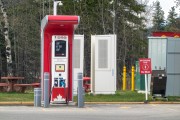Earlier this week, Toronto Mayor Rob Ford's office proposed a private financing deal to pay for a Sheppard subway extension east to Scarborough City Centre and west to Downsview station.
Under this arrangement the city would pay back the private consortium using tax-increment financing and an increased transit-oriented development fee along the Sheppard line. This paints what on the surface may appear to be a rosy picture — build the Sheppard extension and use provincial funds for transit elsewhere in the city.
Reading the fine print
However, digging a little deeper suggests this option is far from being fiscally responsible. It relies on massive development on Sheppard — something current residents themselves may be opposed to, and which is not guaranteed to happen. Without this development, Toronto's taxpayers will have to hand over additional funds to pay the private consortium. Plus, the current Sheppard Subway already loses money in its operation. Adding more expensive capacity will drive operating costs even higher, while there are unlikely to be enough new riders to cover those costs.
Relying on development
 A private developer isn't going to agree to a deal where it loses money — if the area along Sheppard fails to develop sufficiently, the financing still needs to be covered. The city will have to dip into its own pocketbooks to pay for the subway extensions.
A private developer isn't going to agree to a deal where it loses money — if the area along Sheppard fails to develop sufficiently, the financing still needs to be covered. The city will have to dip into its own pocketbooks to pay for the subway extensions.
The history of recent subway development in the city is not encouraging. High densities, over 120 people and/or jobs per hectare, will be needed on Sheppard to fund the expansion. A 2001 TTC report, however, found that only three of 17 transit stations built since 1978 meet that requirement: St. Clair West, McCowan and North York Centre. Those odds — three in 17 — wouldn't make a safe bet, and being on the hook for any part of a $4.4 billion subway extension is not likely to be something the city can afford.
Even if the development fees and property tax gains succeed in raising revenue, those funds would be paying off a debt rather than going into city coffers (where our property taxes and fees usually go), so the city loses out on revenue.
Operating in the red
The current Sheppard subway is already losing money — in 2007 it was estimated that shutting down the Sheppard subway would save the city $10 million per year. Extending the Sheppard subway could exacerbate this problem by adding even more capacity, at great cost, to serve a relatively small number of riders.
 The 2001 TTC report states that "at densities below 100 [people and jobs per hectare], the success of rapid transit cannot be assured and the operational performance of a line may not be financially affordable." This immediately raises a warning flag for subway construction on Sheppard. The density on Sheppard east of Don Mills right now is 68 people and jobs per hectare, while even along the existing Sheppard line it is only 83. Densities projected for 2031 along Sheppard are barely above this threshold — even 20 years from now there likely won't be enough paying riders to justify locking in this level of capacity.
The 2001 TTC report states that "at densities below 100 [people and jobs per hectare], the success of rapid transit cannot be assured and the operational performance of a line may not be financially affordable." This immediately raises a warning flag for subway construction on Sheppard. The density on Sheppard east of Don Mills right now is 68 people and jobs per hectare, while even along the existing Sheppard line it is only 83. Densities projected for 2031 along Sheppard are barely above this threshold — even 20 years from now there likely won't be enough paying riders to justify locking in this level of capacity.
Whether private or public, is a subway on Sheppard the best use of funds?
In addition to delaying new transit service on Sheppard from 2016 to 2020, extending the Sheppard subway east would simply be a bad use of funds. The Pembina Institute has developed a plan that outlines other, more fiscally responsible options for Sheppard, plus other parts of the transit system. It shows how building a light rail transit (LRT) line on Sheppard would cost approximately one-quarter the funding needed to extend the subway, while still moving more than enough passengers to serve the needs of the area.
A further case can be made for light rail with a slight modification to the original LRT proposal, which included underground LRT from Don Mills to Consumers Road. By extending underground transit (either as a subway or light rail) to Pharmacy Road instead, no driving lanes would be lost on Sheppard East.
It's worth noting that extending the Sheppard subway west linking Yonge and Downsview potentially makes sense — congestion on the Yonge line could be relieved and cross-town transit would be improved in North Toronto. However, there are no recent ridership studies for such a line and the impacts, both positive and negative, should be examined more closely before proceeding with extension.
Paying our 'fare' share
To move more new transit underground, Pembina's plan would require a small amount of additional financing from the provincial (or federal) government, but it would absolve Toronto from the financial burden and risk of the mayor's proposed subway line. It would build transit where we need it, and transit that we can afford to operate.






